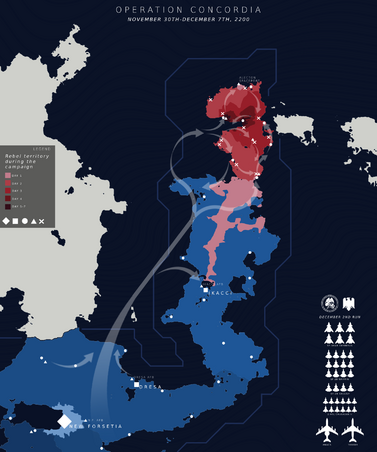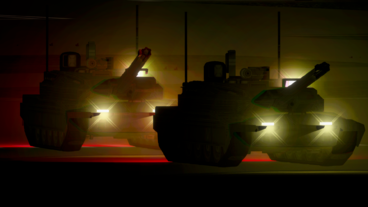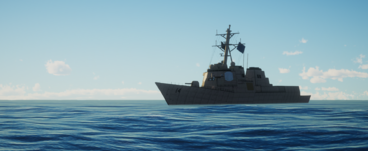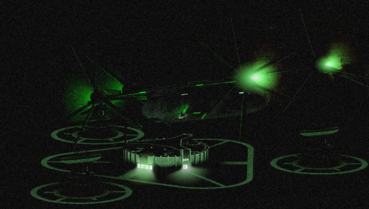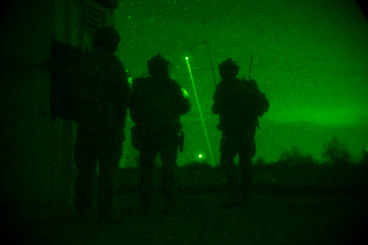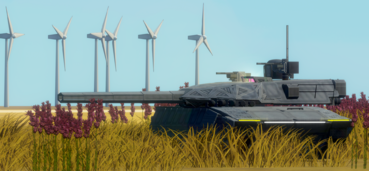Operation Concordia
|
Operation Concordia
|
|||||
|---|---|---|---|---|---|
 |
|||||
| A coalition Z-90L loaded with guided bombs headed towards targets within rebel controlled Alecton | |||||
| Period | |||||
| November 30th, 2200 - December 7th, 2200 | |||||
| Location | Republic of Alecton-Gallante | ||||
| Result | Decisive Government victory | ||||
| Belligerents | |||||
| Caliphate forces | Larrean Armed Forces | ||||
| Thallas Battalion, Alectonese Home Guard (compromised), minor terrorist groups | Alectonese Home Guard (?th army brigade), 1st Areittian army brigade, various Salredi air squadrons, Forsetti Bay fleet (Delras) | ||||
| Strength | |||||
| ~5000 | 6530 | ||||
| Casualties and Losses | |||||
| ~4000 | ~2000 (185 coalition forces, and an estimated 1800 local Alectonese forces) | ||||
Operation Concordia, also known as the 2200 Alecton rebellion, was a military operation performed by the Larrean Armed Forces against a rebelling division of the Alectonese Home Guard. Thought to have been in collaboration with the terrorist Thallas Battalion group, the rebellion started due to ultra-nationalist cells within the Alectonese Home Guard gaining control of local air force and army bases within north Alecton on the morning of November 30th on Larrean unification day. Numbering around 5 battalions of soldiers totaling 5000 men, 20 armored platoons and 100 various aircraft, it was the largest hostile military uprising on the Forsetti peninsula since the civil war. The rebellion was ended one week later, after the central government assembled a combined task force of all Larrean military divisions under the name Concordia, showcasing the first time combined arms warfare was carried out outside of training exercises.
Background
Alectonese Nationalism has historically been a problem within the Larrean Republic, ever since the Unification Front defeated the Caliphate forces during the Forsetti Civil War. Fundementalist Thalassi Krakenism thrives within the rural communities in the densely forested north of the country. Many terrorist organizations and extremist groups within the republic have originated from these deeply religious parts of Alecton-Gallante, but they have historically been dealt with relatively easily by local law enforcement and intelligence. The exception to this rule has been the Thallas Battalion, which has managed to escape from the mainland and has fled the reaches of Larrean law, with many theorizing that they are being given refuge in Zuai by the theocratic government.
The attacks came only days after a Larrean Navy destroyer went missing in the arctic, which had reports of being compromised by Thallas. Journalists were given conflicting answers regarding a Larrean Navy lifeboat that was found near an area where signs of a battle between Thallas and the arctic pirates was detected, with certain sources claiming that a note was found threatening a declaration of war by Thallas and other sources speculating that the pirates were behind it. Since the incident is still classified, it is not publicly known whether or not the government knew of the attacks prior to the 30th.
Timeline
November 30th
The attack started at 9 AM with the hijacking of multiple TV stations, each broadcasting the same video; A masked man sitting at a desk with the old civil war era caliphate flag behind him. The broadcast proclaimed the following:
"Good morning patriots. As we enlightened ones know, the Larrean government is a fascist dictatorship run by a corrupt puppet controlled by corporations. The people have lost their morality and are straying away from Thallas (God). Our ancestral lands beyond our borders are controlled by foreign governments and must be liberated. On this day, 30 years ago, our dream of a caliphate united under the holy law of Thallas was destroyed by the demonic vermin of Delras. Our dream lived on however. Today, we reject the control of the devil. We will show our devotion to Him, and we will build our kingdom. So i proclaim to you, rise up, so we can build our kingdom in heaven and join our ancestors who went through the portal so many years ago. Thallas Vincit Omnia".
It is now believed that this hijacking was performed by the Thallas Battalion, and that the masked figure speaking was their leader known as the Allfather who is considered as the most wanted man in the peninsula with a reward of 10 million Forsa to anyone who can provide information on the man.
After the broadcast finished, reports of explosions emerged all over northern Alecton. Government and other federal offices were targeted and all interstate units stationed nearby were captured. The Rebels, who by now were referring to themselves as "the caliphate", had effectively cut the northern province of Alecton off from the rest of the republic by the afternoon. Captured armoured units and aircraft were patrolling the ground and skies, and reports were made that missiles came flying in off the northern coast of Alecton. Radar stations and SAM sites were also compromised, hindering a swift counterattack from government forces. During the TV Hijacking, a large scale cyberattack was also performed by the rebels, rendering many government websites as well as media applications inoperable. Military installations were also targeted, with communications being cut by the hackers. Compromised armoured units promptly moved south, but stopped after a few dozen kilometers due to a loss of order within the rebel command as conflicting orders were being given on where to advance. This chaos was absolved after a few hours, and the front line moved south rapidly approaching the capital of Ikacci. The space port in the north was also taken over, with little to no violence being involved.
At 6 PM a swarm of suicide drones came flying into Ikacci province, and one hit an appartment complex in the Ikacci suburbs. Come evening, a press release was issued by the central government in New Forsetia, with president Montano stating that this show of rebellion is unacceptable and that the insurgency will be dealt with swiftly. Around this time locally stationed troops engaged in the first large scale firefights with the rebel forces, halting the rebel advance to the outskirts of Ikacci province. A front line was being established, but an estimated 1000 Alectonese home guard troops as well as local law enforcement had already fallen as casualties throughout the day. This loss of life was the largest one since the civil war, and became the single deadliest day of modern Larrean history.
The advance of the rebels had almost completely halted around 10 PM. That evening at exactly 12 PM, the Larrean Armed Forces made their first move.
December 1st
Shortly after midnight in the early morning of December 1st, 8 SF-2B Griffin strike fighters from the 3rd Salredi Air Squadron were scrambled from Tria Air Force base in Salred, together with 2 EF-2B Grizzly electronic warfare aircraft. The combined formation flew north towards the front line in northern Alecton and performed a SEAD run together with a bombing run deep into the controlled area targeting airfields. Rebel radar installations and SAM sites were hit, and the Griffins scored confirmed hits on two airfields near the front line. During the raid however, a few SAM installations managed to get locks onto a number of the Griffins, resulting in three of the fighters being hit and four of the pilots losing their lives. This loss was unexpected but not unforeseen among air force command, considering that Larrean air defence was designed to take down near-peer adversaries, which seemed to have backfired for the SPACOM-built Griffin fighters. Due to this sudden loss of aircraft, the second wave of fighters to perform penetrating operations was put on hold and air force command was forced to reconsider their next move. This halting of operations due to the loss of the aircraft has been credited with extending the conflict much longer, and has been subject to scrutiny in recent times.
Shortly after the loss of the aircraft the formation retreated back from the front lines and landed near Dresa AFB. During this raid, small squadrons of Special Forces Paratroopers from the 1st Areittian army brigade were deployed in the now-destroyed radar blind spots, with the goal of clearing the neutralized air fields and encircling rebels caught between them and the front line during the chaos of the air raid. By morning the SF confirmed the capture of the two destroyed air fields, and captured two rebel camps which were being built near the front line, carving out a multi-kilometer sized chunk from the rebel controlled territory and marking the first territorial gain of government forces. After the SF united with the home guard, the captured rebels were handed over and the combined forces turned back to push forward into the rebel territory. Again, due to the unexpected loss of the three Griffins the scale of the SF deployment was scaled back massively.
Hours later, the first rebel fighter jets had been deployed. Due to the Larrean constitution stipulating that every state must only house one branch of the armed forces in large amounts, the rebels did not manage to acquire any of the advanced stealth fighters, since they were primarily stationed in Salred, with the ones in Alecton being held in the south of the state. However, 30 Z-80EL and 10 Z-90L fighters were captured in the various compromised airfields. Z-80EL's were thus the first to be spotted being deployed by the rebels. The rebel fighters performed a raid on the villages near the front line around 11 AM, with one aircraft striking houses in a town near Ikacci. While home guard troops were equipped with MANPAD's, they did not manage to shoot down any of the rebel fighters. It thus became clear that air superiority had to be established before larger operations could be carried out. The low amount of SF soldiers, although creating a breakthrough in the front line, did not have the expected effect they were thought to have and fighting once again slowed down in the afternoon. Around 5 PM, multiple divisions of the coalition armed forces arrived to the front line, and mobile radar stations and SAM vehicles were set up. The first armoured divisions also arrived, finally providing valuable backup to the now dwindling forces of the home guard. As the day closed, a noticeable buildup of units was seen on both sides of the front line, but due to the lack of rebel munitions and a lack of coalition air superiority no large pushes were made in either direction.
Behind the scenes, air force command were pressuring LAF top brass to deploy the more advanced aircraft within the arsenal, but the unexpectedly high losses of the operation so far discouraged larger scale operations from taking place. After the rebel fighters were spotted conducting successful raids however, the mentality of the command seemed to change. Following careful deliberation, the green light was given for the use of experimental aircraft in the next day of the campaign. It was also now that a new comprehensive plan was drafted for the rest of the operation, which is when the codename Concordia was given.
December 2nd
Just before daybreak on the 2nd of December, fighters were once again scrambled from Tria AFB. This time, as part of the new operation, new units were allowed to be deployed. 3 of the as of yet still prototype versions of the SF-3B Cerberus strike fighters are deployed, with their stealth coatings still being freshly adhered onto their airframe. They are joined by 12 SF-2B Griffins, 4 EF-2B Grizzlies, and 3 of the only finished pre-production versions of the SF-3A models. A second wave of 12 Z-90L's is also deployed. They are reinforced by an AWACS aircraft and an aerial refueling is performed in the Forsetti bay. They are tasked with the complete destruction of all radar, SAM and ballistic missile sites as well as the neutralization of all operating airfields, and plan to hit the southwestern portion of the rebel territory.
The Grizzlies lead this combined squadron, followed by the two models of Cerberus. The first run is performed on first daylight. The rebel forces, having expected such an attack had scrambled fighters of their own to patrol the skies. 15 Z-80EL's are spotted by the AWACS, and the coalition force is updated on the situation. The Grizzlies jam all incoming transmissions, giving the go ahead to the Griffins to fire their missiles towards the rebel Z-80's. Simultaneously, the Cerberus-B bombers use this opportunity to penetrate and go full afterburner into the rebel territory, each loaded with ten 1000 kg guided bombs as well as two cruise missiles and multiple anti-radiation missiles. This wall of electric noise, missiles, and bombers hit the rebel fighters all at once. Understanding their situation, they immediately drop altitude and try to assess the threat. Right at that moment however, 10 of the 15 Z-80's are splashed by the missiles. Simultaneously, the Cerberus bombers pass under them, having successfully penetrated the first layer of rebel fighters and radar and rapidly approaching the first targets. The remaining bandits fire off their own missiles, having gotten faint signatures from the Grizzlies. While their attack got off successfully, the Z-80's are hit with the second wave of missiles from the coalition forces, and are all shot out of the sky. The Grizzlies dodge the incoming missiles, which arrived out of energy due to having been fired beyond their effective range. The coalition formation, having stood back and only fired a few missiles, now all charge ahead towards the enemy airspace. The bombers, which at this point had reached their targets, deploy their payloads and turn around. A total of 3 airfields (including the largest one, XXXX air force base), 10 SAM sites, 5 radar installations and 2 missile stations were hit in the attack, crippling the most valuable parts of the rebel air defense. With hundreds of square kilometers now being neutralized, the formation splits up and pushes ahead. The Cerberus bombers are given permission to return back to Salred, while the rest of the formation prepares for the second phase of the attack.
The massive strike prompted the rebels to scramble all of their remaining aircraft into the skies, not anticipating the scale of the counterattack. As time passes, all remaining 25 fighters of the rebels get up in the air, but are picked off one by one. After half an hour in the sky, all rebel fighters had been neutralized. As the formation is running out of missiles, they perform the last part of the operation and proceed to neutralize the rest of the rebel air defenses, rotating out aircraft as they each run out of munitions or fuel. By 7 AM, all major targets in the rebel controlled area are destroyed. Coalition air dominance is established at last, having lost only one aircraft (a crusader II) with no loss of life. The air operation was the largest since the civil war.
The arrival of mechanized forces during the last night, together with the air strikes, set up the next step of the revised ground operation. Mass coalition artillery fire commenced at 7 AM, now not being in danger of rebel aircraft, and would not stop until 12 hours later and targeting all the rebel encampments near the front line. At 8 AM USLS Dresa and USLS Novum Forsetia of the New Forsetia class launched cruise missiles into the now devoid of defenses rebel territory, neutralizing the final large military installations. All that is left are the military forces at the space port and the major cities, which due to the risk of civillian casualties had been unscathed. Due to this however, many of the rebel forces moved from their positions towards towns and cities, realizing that the coalition won't bomb them if they hide among civilians. By midnight, the armed forces had flattened almost all defensive positions of the rebels. The plains, swamps and jungles of northern Alecton had now become hazy with dust, and reeked of gunpowder. Due to a severe thunderstorm that rolled in shortly after midnight, operations ceased until the following morning due to the already difficult to traverse terrain having become hazardous.
December 3rd
At 5 AM, the weather conditions improved and ground operations could commence once more. While a path had now been cleared, charging forward would not be the optimal strategy. Since most rebel forces had now gone into hiding among civilian populations, the next phase of operation Concordia would be defined by urban combat. The tanks and artillery which had stationed themselves along the southern front line rolled forward, and swift progress was made by the coalition forces. The armored vehicles belonging to the rebels had become inoperable due to a lack of ammunition, supply lines and fuel. Dozens of vehicles lay scattered among the roads, abandoned yet in perfect condition. The highway system proved effective, just as it had facilitated the blitz-attack of the rebels it now provided a direct route through compromised territory. Progressed would only be slowed down due to coalition forces clearing out towns and cities, to recapture and eliminate remaining rebels. As the convoys moved ever further north and as the sun began descending more and more, liberation of settlements slowed down considerably due to increased ferocity in the skirmished within the cities. Where the rebels had surrendered in droves close to the front line, further north their resolve proved more formidable. Tank combat flared up around sunset, as the remaining operable armored divisions of the rebels had moved further north to prepare for defensive engagements against the coalition forces. At 11 PM, the southern coalition forces had reached the shores of the northern bay.
While the coalition forces in the south were clearing a way through the Alecton heartland, another assault was being carried out. During the thunderstorm of the early morning, at 3 AM, amphibious assault ships of the Delrassi fleet had sailed north, and stationed themselves off the coast near the space port. They carried with them multiple landing craft and supply vehicles, as they were preparing for a beach landing. The thunderstorm, which had become a roadblock for the southern front, had provided cover and concealment for the northern assault. Supplementing the amphibious landing, multiple squadrons of paratroopers of the 1st and 2nd Areittian army brigades would once more attempt a landing, this time also targeting the north. Ten LV-700 Super Ajax heavy VTOLs disembarked from their ships, carrying with them a multitude of armoured vehicles and troops. The plan was to capture the space port and liberate northern Alecton, forcing the rebels to fight on two fronts. The operations would commence at sunrise, when conditions were clear.
As the horizon slowly became filled with light, the landing craft raced towards the beaches, and the paratroopers and their vehicles started descending near the runway of the spaceport. While most rebel defenses in the area had been moved towards the south, a formidable force was still present at the space port due to it being spared in the previous day's bombardments. First shots would be fired when the rebels, who had been caught completely off guard, met the coalition special forces while attempting to rearm helicopters near the runway. Simultaneously, the landing craft had deployed almost all their troops and vehicles, and the formation raced towards the spaceport. The battle of the gates to heaven, as the media dubbed it, had officially begun at the space port. Special forces cleared the hangars near the runway and made their way southeast towards the launchpads and the space port facilities, while the amphibious troops with their vehicles made their way towards the defenses at the southwestern portion of the port. Coalition casualties were few, as the special forces had now become used to fighting their former countrymen. The two coalition forces met at the vehicle assembly buildings of the port, and the massive buildings became a temporary prison for all the captured rebels. Vehicles and supplies were exchanged as the forces prepared for rebel reinforcements. Enemy armored vehicles began entering the perimeter of the port, and began engaging coalition forces. Tank-on-tank combat began, and soon the port's facilities began taking damage from the fighting. At 1 PM, nearly 7 hours after the landing, the space port was declared liberated. The Larrean flag was raised on the top of the main VAB, and the caliphate black standard which had waved there for 80 hours was lowered and burned.
Similar to the southern assault, the northern landing and subsequent liberation went quick once the defenses were knocked down. Around afternoon, once all the fighting at the space port concluded, virtually nothing stood between the coalition forces and progressing southward due to the rebels allocating their resources to the southern front. The sparse population of the north made it such that, even though the northern forces had considerably less troops than the southern forces, they made quick work of the northwestern portion Alecton. At 10 PM, northern forces had reached the northern shore of the Alecton bay and had created a spearhead towards the largest settlement of the bay, where most rebel forces by then had retreated to.
December 4th
MBTs punch through all the way to the north, reunite with the space port. Most of the rebel controlled territory is captured by now
December 5th
rebels hunker down in their stronghold, Thallas units reinforce them
December 6th
bunker busters flush out the underground facilities
December 7th
last rebels are captured
Aftermath
-
